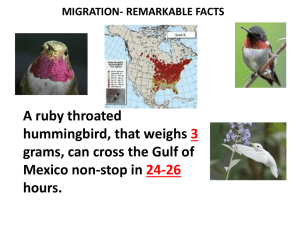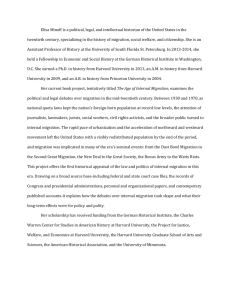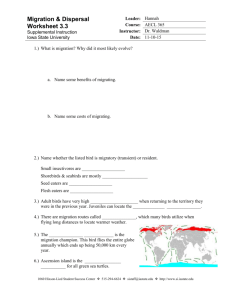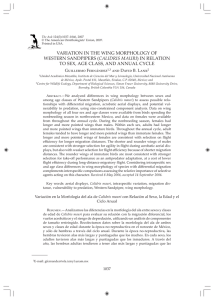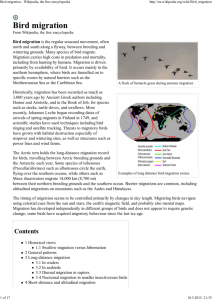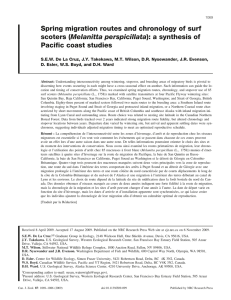Dichrom-Isl
advertisement
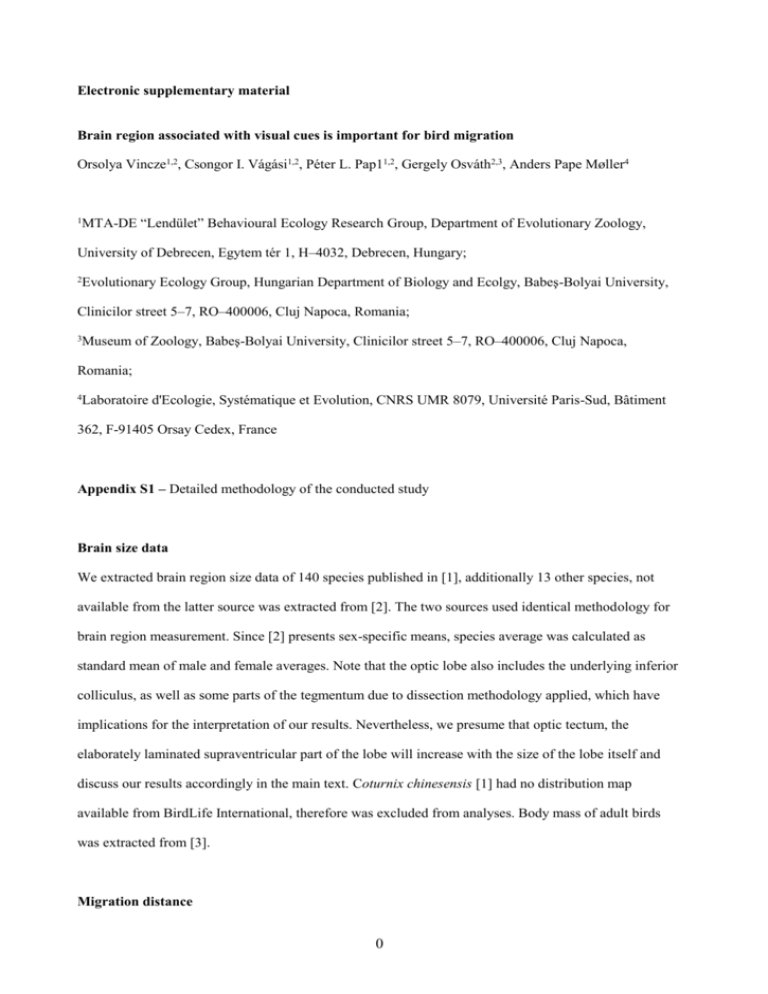
Electronic supplementary material Brain region associated with visual cues is important for bird migration Orsolya Vincze1,2, Csongor I. Vágási1,2, Péter L. Pap11,2, Gergely Osváth2,3, Anders Pape Møller4 1MTA-DE “Lendület” Behavioural Ecology Research Group, Department of Evolutionary Zoology, University of Debrecen, Egytem tér 1, H–4032, Debrecen, Hungary; 2 Evolutionary Ecology Group, Hungarian Department of Biology and Ecolgy, Babeş-Bolyai University, Clinicilor street 5–7, RO–400006, Cluj Napoca, Romania; 3 Museum of Zoology, Babeş-Bolyai University, Clinicilor street 5–7, RO–400006, Cluj Napoca, Romania; 4Laboratoire d'Ecologie, Systématique et Evolution, CNRS UMR 8079, Université Paris-Sud, Bâtiment 362, F-91405 Orsay Cedex, France Appendix S1 – Detailed methodology of the conducted study Brain size data We extracted brain region size data of 140 species published in [1], additionally 13 other species, not available from the latter source was extracted from [2]. The two sources used identical methodology for brain region measurement. Since [2] presents sex-specific means, species average was calculated as standard mean of male and female averages. Note that the optic lobe also includes the underlying inferior colliculus, as well as some parts of the tegmentum due to dissection methodology applied, which have implications for the interpretation of our results. Nevertheless, we presume that optic tectum, the elaborately laminated supraventricular part of the lobe will increase with the size of the lobe itself and discuss our results accordingly in the main text. Coturnix chinesensis [1] had no distribution map available from BirdLife International, therefore was excluded from analyses. Body mass of adult birds was extracted from [3]. Migration distance 0 We obtained distribution maps (shape files) for each species from http://www.birdlife.org/datazone/info/spcdownload [4]. Using these distribution maps, we calculated the geometric centroids of the spatial polygons of breeding (breeding and resident) and wintering (wintering and resident) ranges for each species using the ‘gCentroid’ function of the R package ‘rgeos’ [5]. Migration distance was then calculated as the geographic distance between breeding and wintering centroids using a custom function [6] written in R 3.2 [7]. Migratory distance calculated here represents the average distance travelled by a given species during migration. Wing morphology Aerodynamic theory predicts that wing architecture defines flight capacity, and, therefore, wing morphology is often linked to migration distance [8]. To control for this effect, we measured wing area (m2) and aspect ratio as wing area divided by wingspan (m) squared (therefore, dimensionless measure [m2/m2]) using photographs or drawings of fully stretched wings with the leading edge perpendicular to the body axis (for the details see Vágási et al. submitted). Note that data on wing morphology was only available for 91 out of the 152 species, and, therefore, models containing any of these two variables are restricted to 91 species. Statistical analyses We log10-transformed all variables prior to analyses in order to ensure model residual normality. A constant of one was added to migration distance prior to transformation to avoid problems with migration distances of 0 (i.e. residents). All statistical analyses were conducted using R [7]. To assess how migration distance relates to wing morphology and brain region sizes we used multivariate phylogenetic generalized least squares regressions (PGLS), as implemented in the R package “caper” [9]. Migration distance was used as dependent variable, while all others variables were included as explanatory variables. In order to control for similarity due to common phylogenetic descent, we used an ultrametric, rooted phylogenetic tree, calculated based on 1000 random trees with Hackett backbone [10], accessed from www.birdtree.org 1 [11], using the ‘sumtrees’ software [12]. Phylogenetic dependence was estimated using Pagel's λ and was set to the most appropriate value assessed by maximum likelihood in each model. We performed p-value based stepwise backward model selection on multivariate models, with a threshold value of 0.05. Body mass was retained in all models to control for body size effects. We present both full and minimal models. Note that all four brain region sizes are highly correlated with body mass, potentially causing multicollinearity problems in multivariate models. Therefore, we repeated each analysis using massadjusted brain sizes. For this, scaling exponents were extracted from PGLS regressions between log brain (region) size and log body mass as implemented in R package “caper” [9]. Scaling exponents (b; i.e. the slope of the PGLS regression) were the following: whole brain: 0.615; telencephalon: 0.658; optic lobe: 0.454; cerebellum: 0.599. Scaling exponents for only passerines (n = 38 species, whole brain: 0.674; telencephalon: 0.719; optic lobe: 0.546; cerebellum: 0.632). Mass-adjusted brain region values were computed as raw brain (region) size divided by body mass raised to power b. Models based on massadjusted brain sizes yielded highly consistent results with models based on log-transformed data, indicating that collinearity is not a major issue in our analyses (Table S1 b–c). SUPPLEMENTARY REFERENCES 1. Portmann A 1947 Études sur la cérébralisation chez les oiseaux: II. Les indices intra-cérébraux. Alauda 15, 1–15. 2. Kalisinska E 2005 Anseriform brain and its parts versus taxonomic and ecological categories. Brain Behav. Evol. 65, 244–261. (doi:10.1159/000084315) 3. Cramp S, Perrins CM (eds) 1977–1994 The birds of the Western Palearctic. Vols. 1–9. Oxford University Press, Oxford. 4. BirdLife International, NatureServe 2012 Bird Species Distribution Maps of the World, Version 2.0. BirdLife International and NatureServe, Cambridge, UK and Arlington, TX. 5. Bivand R, Rundel C 2013 Rgeos: Interface to Geometry Engine - Open Source (GEOS). R Package Version 0.3-2. 2 6. Vágási IC, Pap PL, Vincze O, Osváth G, Erritzoe J, Møller AP 2015 Morphological adaptations to migration in birds. Evolutionary Biology, 1-12. (doi:10.1007/s11692-015-9349-0) 7. R Core Team 2015 R: A Language and Environment for Statistical Computing. R Foundation for Statistical Computing, Vienna, Austria. 8. Newton I 2007 The migration ecology of birds. London, UK: Elsevier. 9. Orme D, Freckleton R, Thomas G, Petzoldt T, Fritz S, Isaac N, Pearse W 2013 caper: Comparative Analyses of Phylogenetics and Evolution in R. R package version 0.5.2. 10. Hackett SJ, Kimball RT, Reddy S, Bowie RCK, Braun EL, Braun MJ, Chojnowski JL, Cox WA, Han KL, Harshman J et al. 2008 A phylogenomic study of birds reveals their evolutionary history. Science 320, 1763–1768. (doi:10.1126/science.1157704) 11. Jetz W, Thomas G, Joy J, Hartmann K, Mooers A 2012 The global diversity of birds in space and time. Nature 491, 444–448. (doi:10.1038/nature11631) 12. Sukumaran J, Holder MT 2010 DendroPy: a Python library for phylogenetic computing. Bioinformatics 26, 1569-1571. (doi:10.1093/bioinformatics/btq228) 3



